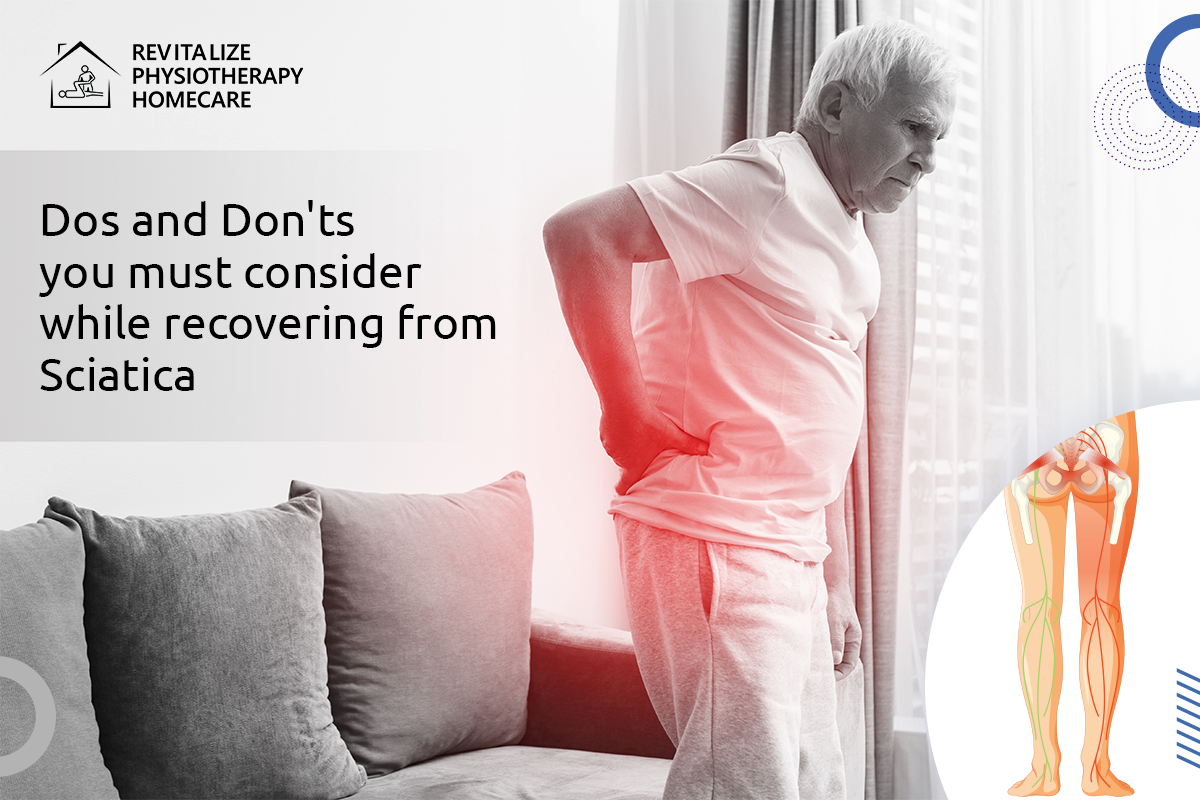Dos and Don’ts you must consider while recovering from Sciatica
Sciatica is a common cause of chronic back pain.
Sciatica refers to the condition that affects the sciatic nerve, which runs through the lower back and the hips. This type of pain occurs when the disc in your lower back is herniated. It's most common in pregnant women during childbirth. Soft discs are small and fit between the vertebrae of your spine. These discs can become herniated if they move in one direction or another with force.
Herniated discs can put pressure on the sciatic nerve.
Sciatica is a common but often misunderstood type of disorder. It has affected up to 40% of people in their lifetime. Sciatica is often confused with back pain. However, it is not the same.
Sciatica is a pain that originates in the sciatic nerves. It often disappears by itself within a few days or hours. Some attacks may last for weeks, or even months. There are many Sciatica Pain Treatment Brampton you can consider to alleviate sciatic pain.
How does Sciatic pain feel like and some symptoms of sciatica:
Sciatica is characterized by a burning, shooting, or sharp sensation in the buttocks, back, thighs, legs, which can go down to the feet and toes. Patients may experience weakness in their legs or numbness if there is severe compression.
Sciatica is caused by a prolapsed/slipped intervertebral disk. The prolapsed soft tissue between the vertebrae is common due to age-related degenerative changes. However, it may also occur in response to accident/trauma/injury. Sciatica can be caused by a slipped disc pressing on the nerve roots. These symptoms can be worsened by bending forward, coughing, or sneezing.
Sciatica refers to a condition that affects one of the most important nerves in the body, the sciatic nerve.
Sciatica symptoms include the following:
- Sciatica can cause tingling or numbness in the foot, leg, or toes. It is sometimes described as a pins and needles sensation.
- Sciatica may cause weakness in the leg that makes it difficult to support or move the body's weight.
- Sciatica can cause difficulty in standing or sitting.
- People with sciatica might also feel lower back pain.
- Sciatica symptoms can be severe and long-lasting.
Some cases may go away without any treatment, while others may require immediate medical attention. For a diagnosis and treatment plan, it is best to visit a Physiotherapy Clinic Brampton.
Here are the Do you must consider when trying to Recover from Sciatica
1. Do more exercise
Exercise is key to preventing or relieving sciatica.
Here are some of the exercises you can consider:
- Aerobic exercise: Walking, running, swimming, cycling and dancing.
- Strength training: Exercises that use weight machines, free weights, or isometric exercises which contract muscles without apparent movement.
- Yoga, Tai Chi, Pilates and other similar activities can be used to increase flexibility and strength.
You can consider any of these exercises that you enjoy doing regularly will help.
2. Strengthen your core
Although it may not be obvious, a strong core can improve spinal health. Your core does not include your abdominal muscles. However, they are crucial contributors to your spine's stability. Your core also includes muscles in your back, sides and pelvis. Your spine will be supported if you strengthen all these muscles.
Yoga and Pilates are just two of many types of exercises that can strengthen core muscles. Planks and bridges, for example, also target the core.
3. Do not sit for a long period of time
Long periods of sitting can put strain on the ligaments and discs in your low back. Which is why it is always prescribed to take breaks if you are doing a job that requires sitting a lot.
It is always better to sit less.
4. Take control of your weight
Sciatica can be caused by obesity or being overweight. People who are obese or have sciatica tend to heal slower. Why? The reason is that weight gain can put pressure on the spine, which can cause herniated discs. Even a small weight loss can reduce inflammation and pressure on your spine.
5. Good posture is key to good health
Our elders were always right, slouching is bad for the spine.
To practice good posture, you don't need to carry a book around with you. These are some tips to help you get started.
- When you are standing or sitting, pay attention to the position of your body.
- Pull your shoulders back and down to prevent slouching. Think of your shoulder blades touching.
- Take frequent breaks if you are working at a computer.
You should position your monitor so that you can see it clearly without tilting your head back or bending your head.
Here are some Don'ts you must avoid when trying to recover from Sciatica
1. Avoid exercises that over stretch your hamstrings
Overstretching your hamstrings can lead to sciatica.
Straight-leg sit ups, bending forward and touching the toes, squats using weights, and downward dog are some of the exercises you should avoid. Instead, make circles with your legs while your other leg is up and one leg is down. Professional physiotherapists also suggest taking a walk to warm up your muscles and swimming to reduce your weight.
2. Avoid Bed Rest
You can remain in bed for 48 hours if you're really in pain. If you're in severe sciatica and can't find a comfortable place, you may have no other options but to rest.
However, if the pain is not severe then you must avoid resting for too long. It's important to keep moving. Take control of your pain by taking medication. Then get moving. You can try gentle stretching, walking or swimming.
3. Avoid Twisting Your Spine
It is important to avoid twisting motions when combined with other movements such as forward or side-bending. This can cause injury to your lower back and joints. Shoveling snow or lifting objects in an incorrect way is a good example of twisting spine while bending.
Instead, learn how to lift things. Stretch and core strengthening exercises are important to increase flexibility and range of motion.
4. Avoid Long Car Trips
It is not always possible to do this, but it can be done when you're not on a long trip.
When your car is in its right place, don't slump. Before you drive, adjust your rearview mirror to ensure it is in the correct spot. After driving for some time, if you have difficulty seeing the mirror it could be a sign that you are slouching.
Instead, find a rest stop and take a walk for a few minutes.
Sitting in a more flexed position can increase the pressure on your spine. It is therefore important to reverse this.
5. Do not lift heavy weights before warming up
Olympic lifts, weighted deadlifts and weighted squats can increase the load and strain on the spine. If you train with weights, make sure to stretch before starting to work out.
Instead, practice strengthening and stretching that starts with gentle range-of-motion exercises. These exercises can reduce inflammation of your back muscles and improve mobility to prevent injury.
Conclusion
There are many ways to avoid sciatica pain. However, reaching out to a professional Brampton Physiotherapist for rehab is the best.
Physiotherapy is the best way to get physical rehabilitation for all kinds of back pain. Physiotherapy techniques can be used to help patients suffering from sciatica and live a more pain-free and healthier life.
At Revitalize Physiotherapy and Homecare, our team of experts can help you ease your pain using proven methods. Many patients have come to us with sciatica pain. We've helped many of them. We would love to assist you too!
Book an appointment with us now!




